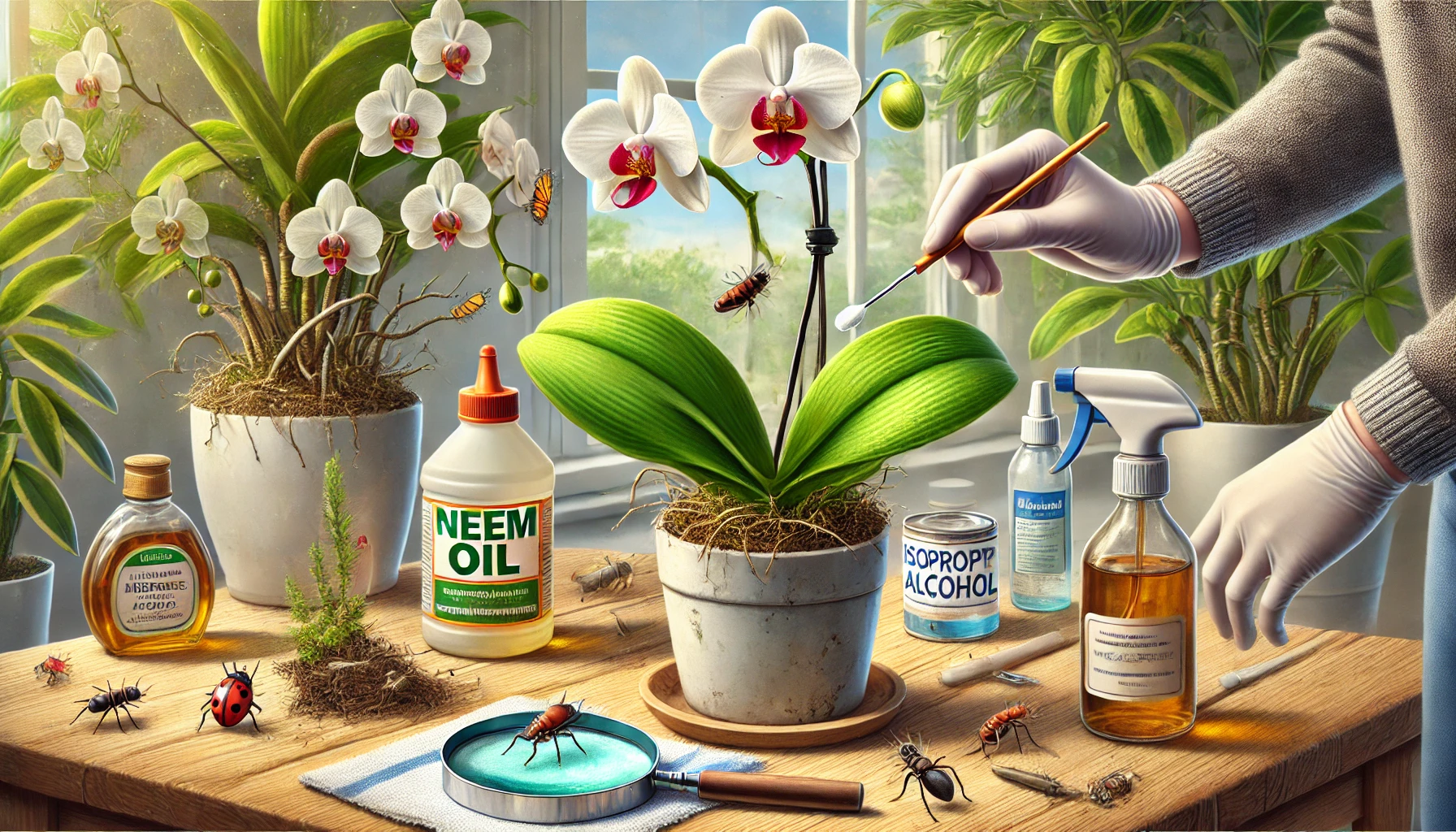Pests are one of the biggest threats to orchids, weakening the plant, damaging leaves, and even preventing blooming. If left untreated, infestations can spread and severely harm your orchid. Fortunately, you can eliminate orchid pests naturally without using harsh chemicals. Identifying the problem early and applying the right treatment will help keep your orchid strong and pest-free.
🌱 Common Pests That Attack Orchids
Several pests target orchids, feeding on their leaves, roots, and flowers. Each type causes different symptoms, so knowing how to identify them is the first step in treating the problem.
✔ Spider Mites
- Tiny red or brown pests that suck nutrients from leaves.
- Symptoms: Fine webbing on leaves, yellow spots, dry or speckled foliage.
- Thrive in dry, warm conditions.
✔ Aphids
- Small, green, black, or white soft-bodied insects found on new leaves and flower spikes.
- Symptoms: Sticky residue on leaves, distorted new growth, ants crawling around the plant.
- Reproduce quickly, forming large clusters.
✔ Mealybugs
- White, cotton-like insects that hide in leaf joints and roots.
- Symptoms: Sticky residue, stunted growth, yellowing leaves.
- Secrete a sugary substance that attracts ants and promotes mold growth.
✔ Scale Insects
- Hard, shell-like pests attached to leaves and stems.
- Symptoms: Brown, yellow, or black bumps that don’t move, weakening leaves.
- Difficult to remove without physical scrubbing.
✔ Thrips
- Thin, black or brown flying insects that attack flowers and leaves.
- Symptoms: Deformed flowers, silver streaks on leaves, browning buds.
- Often hide under leaves, making them hard to spot.
💡 Regularly inspect your orchid’s leaves, stems, and roots to catch pest infestations early!
🛠 How to Get Rid of Orchid Pests Naturally
Once you’ve identified the pest, you can use natural solutions to eliminate the infestation without harming your orchid.
🧴 Method 1: Neem Oil Spray (Best for Most Pests)
✔ Mix 1 teaspoon of neem oil with 1 quart of water and a few drops of dish soap.
✔ Spray all over the orchid, including under the leaves and in crevices.
✔ Repeat every 5–7 days until pests are gone.
🍶 Method 2: Isopropyl Alcohol (Best for Mealybugs and Scale)
✔ Dip a cotton swab in 70% isopropyl alcohol and wipe off mealybugs and scale insects.
✔ For severe infestations, spray diluted alcohol (50/50 mix with water) on affected areas.
🧼 Method 3: Insecticidal Soap (Best for Soft-Bodied Pests)
✔ Mix a few drops of mild dish soap with water and spray the leaves.
✔ Rinse the plant after a few hours to prevent soap buildup.
🌿 Method 4: Garlic or Cinnamon Spray (Natural Fungicide and Pest Repellent)
✔ Steep 1 crushed garlic clove in 1 cup of water, strain, and spray onto the plant.
✔ Alternatively, mix 1 teaspoon of cinnamon powder with water and spray for a natural antifungal effect.
🌊 Method 5: Washing with Water (Best for Spider Mites and Aphids)
✔ Rinse the orchid leaves with lukewarm water to wash away mites or aphids.
✔ Use a gentle brush to remove pests hiding in leaf joints.
💡 Always test sprays on a small part of the leaf first to ensure they don’t damage the plant.
🏡 How to Prevent Orchid Pests Naturally
Once you’ve removed pests, taking preventative measures will help protect your orchid from future infestations.
✔ Improve Air Circulation
- Pests thrive in stagnant, humid air.
- Place orchids near a gentle fan or in a well-ventilated room.
✔ Keep Humidity Balanced
- Spider mites love dry air, while mealybugs thrive in excess moisture.
- Maintain humidity at 50–70% and monitor for changes.
✔ Use Companion Plants
- Place basil, lavender, or marigolds near orchids to naturally repel pests.
✔ Regularly Inspect Leaves and Flowers
- Check under leaves and near flower spikes once a week.
- Early detection prevents major infestations.
✔ Quarantine New Plants
- New orchids can carry pests that spread to other plants.
- Keep new plants separate for 2–3 weeks before placing them near other orchids.
💡 A clean growing environment is key to keeping pests away!
🚫 Common Mistakes That Attract Orchid Pests
❌ Overwatering – Creates a damp environment perfect for fungus gnats and mealybugs.
❌ Ignoring Early Signs of Pests – Waiting too long allows infestations to spread.
❌ Using Chemical Pesticides Too Often – Harsh chemicals can weaken the plant and kill beneficial insects.
❌ Crowding Orchids Together – Reduces airflow, making it easier for pests to multiply.
🌿 How to Recover an Orchid After a Pest Infestation
After eliminating pests, your orchid may need extra care to recover fully.
✔ Trim damaged leaves or flower spikes with sterilized scissors.
✔ Repot in fresh bark mix if pests were in the roots or potting medium.
✔ Reduce stress by keeping the orchid in a stable environment (avoid temperature fluctuations).
✔ Use a diluted fertilizer (20-20-20) to encourage new growth.
💡 Be patient—orchids can take a few weeks to regain strength after a pest attack.
🛡 Final Tips for Keeping Orchids Pest-Free Naturally
✔ Inspect your orchid weekly to catch pests early.
✔ Maintain good air circulation and balanced humidity levels.
✔ Use natural sprays like neem oil or garlic water to prevent infestations.
✔ Keep orchids separate from infected plants to stop pest spread.
✔ Avoid overwatering—healthy roots make orchids less vulnerable to pests.
By following these natural pest control methods, your orchid will stay strong, vibrant, and pest-free, ensuring long-lasting growth and beautiful blooms! 🌸✨
